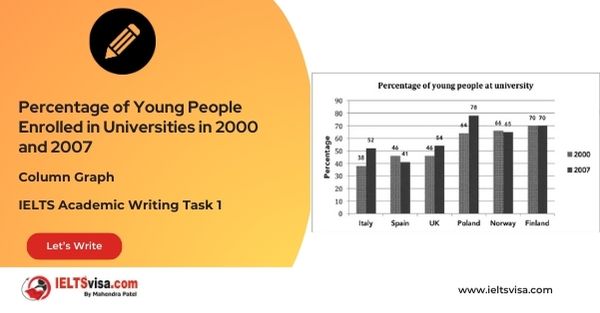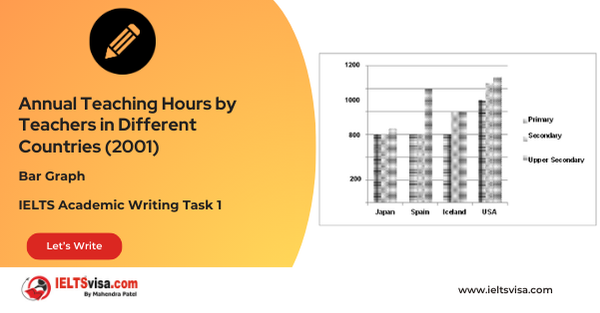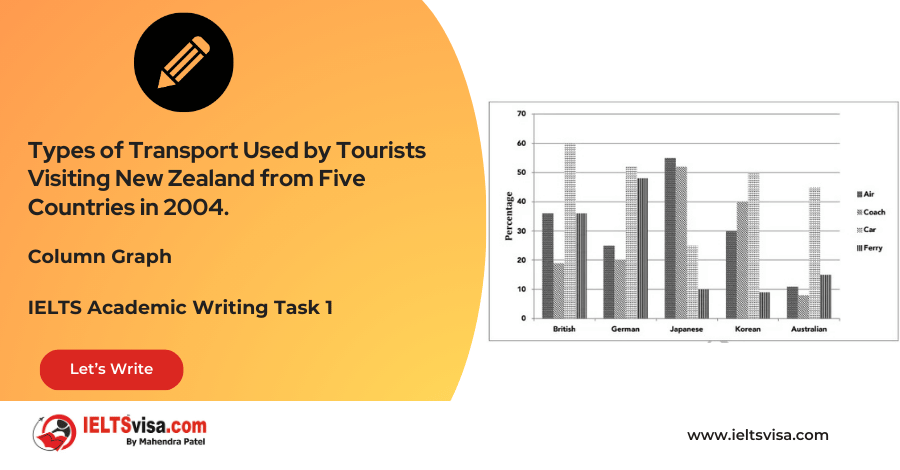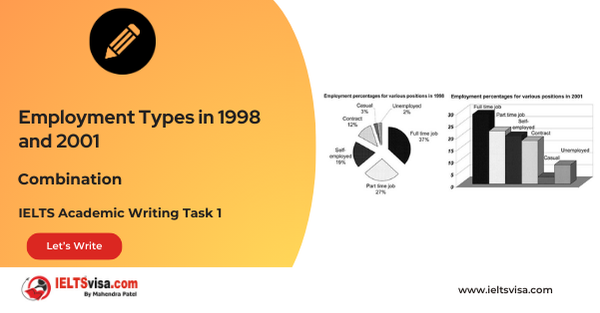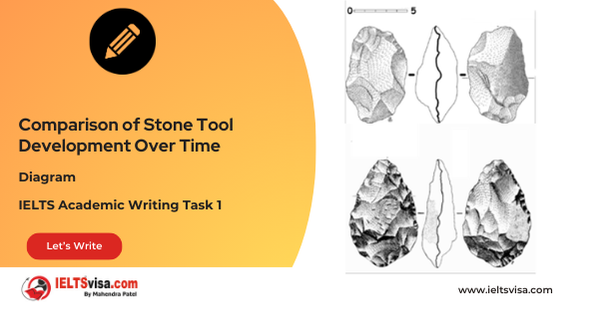Area in 1980 and after the Construction of a Hydroelectric Dam (1990)
IELTS Academic Writing Task 1 - Diagram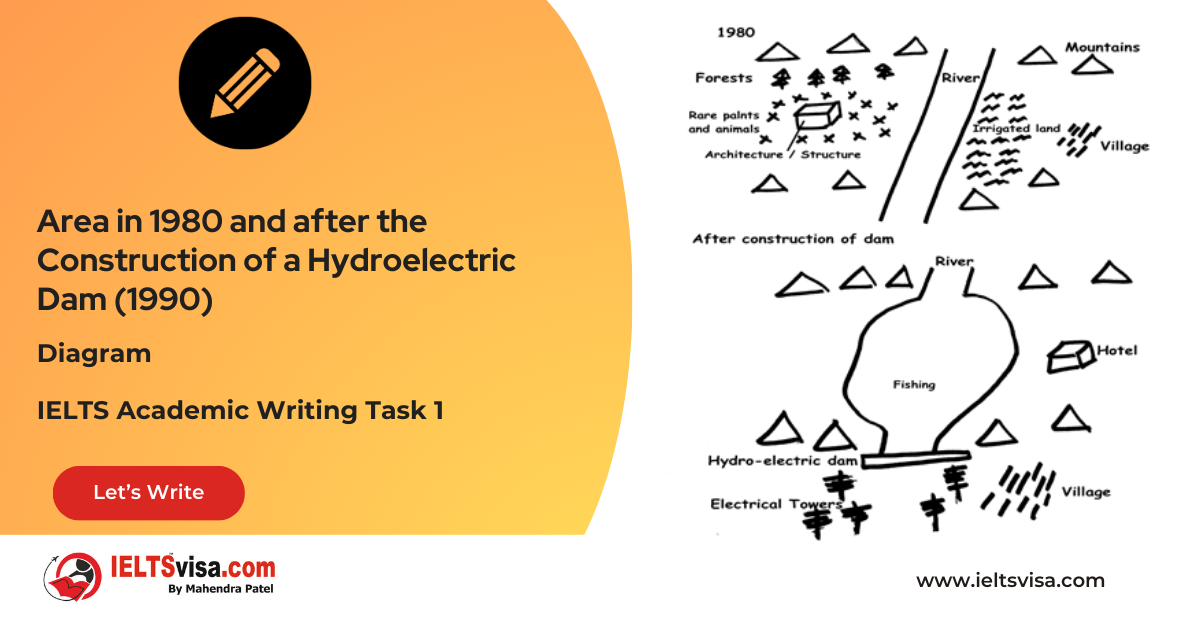
IELTS Writing Task 1 Question
The picture below shows a place in 1980 and after the construction of a hydroelectric dam in 1990.
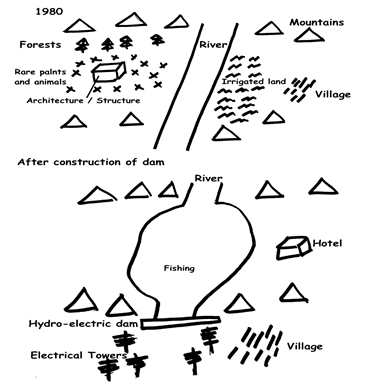
Common questions for the layout of the hydroelectric dam
1. Graph Type: Diagram
2. Title: Area in 1980 and after the Construction of a Hydroelectric Dam (1990)
3. What are the units of measurement?: No specific units; the diagram shows changes in land use and features.
4. Who: This layout compares the area before and after the dam’s construction.
5. When: The diagram compares the situation in 1980 and 1990.
6. Where: The location is unspecified but involves a river surrounded by mountains.
7. Topic: The impact of a hydroelectric dam on the environment and infrastructure.
Process Showing and Trends
Land Use Before and After the Dam Construction
- In 1980, the area was characterized by a river, a forest to the left, structures near the river, and irrigated land on the right side, which was near a village. In 1990, the land underwent significant transformation, with the forest and structures removed. The irrigated land was replaced by a hotel, and the village moved southeast.
River and New Infrastructure
- The construction of the hydroelectric dam in 1990 enlarged the river, and new infrastructure like electrical towers was built near the dam. The area became more modern with the introduction of a hotel and the addition of fishing opportunities, but the change also led to the loss of some biodiversity.
Sample Answer
The diagram compares the layout of a region in 1980 and after the construction of a hydroelectric dam in 1990.
In 1980, a river flowed from north to south through a mountainous region. On the left bank of the river, there was a forest and some architectural structures, while rare plants and animals were located near the structures. On the right bank, large irrigated land was situated next to a village.
By 1990, the area had undergone significant changes. The forest was cleared, and the structures were removed. The irrigated land was replaced by a hotel, and the village was relocated to the southeast. A hydroelectric dam was built in the southern part of the river, which enlarged the river, allowing for fishing activities. Electrical towers were constructed south of the dam.
Overall, the area became more modern and functional for people, but the construction of the dam resulted in the loss of some natural biodiversity.
Top 25 Vocabularies
| Vocabulary | Meaning | Synonyms | Examples | Type |
|
Radically |
In a significant or dramatic way |
Drastically, significantly |
“The area changed radically after the dam was built.” |
Adverb |
|
Irrigated |
Land supplied with water for farming |
Watered, cultivated |
“The large irrigated land was replaced by a hotel.” |
Adjective |
|
Enlarged (verb) |
Made bigger or expanded |
Expanded, increased |
“The river was enlarged after the dam was constructed.” |
Verb |
|
Biodiversity (noun) |
The variety of plant and animal life |
Ecosystem diversity, biological variety |
“Some biodiversity had to be sacrificed for the dam.” |
Noun |
|
Functional (adjective) |
Designed to be useful and practical |
Practical, efficient |
“The area became more modern and functional for people.” |
Adjective |
|
Alteration |
A change or modification in something |
Change, modification |
“The area underwent significant alteration after 1990.” |
Noun |
|
Relocate |
To move to a new place or position |
Move, transfer |
“The village was relocated to the southeast after the dam.” |
Verb |
|
Inundate |
To flood or cover with water |
Flood, overwhelm |
“The construction of the dam caused the area to become inundated.” |
Verb |
|
Replaced |
To substitute one thing for another |
Substituted, exchanged |
“The hotel replaced the irrigated land in 1990.” |
Verb |
|
Development |
The process of improving or expanding something |
Progress, expansion |
“The development of the hydroelectric dam brought many changes.” |
Noun |
|
Facilitate |
To make something easier or more efficient |
Ease, assist |
“The dam facilitates fishing activities in the enlarged river.” |
Verb |
|
Ecosystem |
A biological community of interacting organisms and their environment |
Habitat, environment |
“The ecosystem was impacted by the construction of the dam.” |
Noun |
|
Displaced |
Forced to move or relocated from one’s original position |
Removed, relocated |
“The structures were displaced to make way for the dam.” |
Adjective |
|
Erosion |
The gradual destruction of something, often by natural forces |
Wear, decay |
“The erosion of the riverbanks was controlled by the dam.” |
Noun |
|
Restructured |
To organize or arrange something in a new way |
Reorganized, redesigned |
“The region was restructured after the construction of the dam.” |
Verb |
|
Absence |
The state of not being present or not existing |
Lack, nonexistence |
“The forest’s absence marked the significant change in 1990.” |
Noun |
|
Altered |
Changed or modified in appearance or structure |
Modified, adjusted |
“The landscape was altered drastically by the dam.” |
Adjective |
|
Artificial |
Made or produced by human beings rather than occurring naturally |
Synthetic, man-made |
“The lake created by the dam is an artificial body of water.” |
Adjective |
|
Transform |
To change something completely in form or appearance |
Convert, change |
“The area was transformed into a more modern and functional space.” |
Verb |
|
Diversified |
To vary or make more diverse in form or nature |
Varied, expanded |
“The region’s activities diversified with the construction of the dam.” |
Verb |
|
Innovative |
Featuring new methods or ideas |
Creative, groundbreaking |
“The dam introduced an innovative way to harness water for energy.” |
Adjective |
|
Compensate |
To make up for something lost or damaged |
Make amends, offset |
“The hotel helped compensate for the loss of land.” |
Verb |
|
Expansion |
The action of becoming larger or more extensive |
Growth, increase |
“The dam contributed to the expansion of the river.” |
Noun |
|
Preserve |
To maintain or keep something in its original state |
Conserve, protect |
“The biodiversity of the region was partially preserved despite the construction.” |
Verb |
|
Sustain |
To keep something going or maintain it over time |
Maintain, uphold |
“Efforts were made to sustain the local wildlife despite the changes.” |
Verb |

Our Books
Master IELTS Speaking Part 1
IELTS Writing Task 1 Book
IELTS Writing Task 2 Book
Practice IELTS Other Modules
IELTS Listening
The IELTS Listening test assesses how well you can understand spoken English in various contexts. It lasts about 30 minutes and is divided into four sections with a total of 40 questions. The listening tasks become increasingly difficult as the test progresses.
IELTS Academic Reading
The IELTS Academic Reading section assesses your ability to understand and interpret a variety of texts in academic settings. It is designed to evaluate a range of reading skills, including skimming for gist, reading for main ideas, reading for detail, understanding inferences, and recognizing a writer's opinions and arguments.
IELTS Speaking
The IELTS Speaking test assesses your ability to communicate in English on everyday topics. It lasts 11-14 minutes and consists of three parts: introduction, cue card, and a discussion based on the cue card topic.
IELTS General Reading
IELTS General Reading tests your ability to understand and interpret various types of texts. Here are some key areas and types of content you can expect to encounter in the reading section, along with tips for effective preparation.
IELTS Academic Writing Task 1
In IELTS Academic Writing Task 1, you are presented with a visual representation of information, such as graphs, charts, tables, or diagrams, and you are required to summarize, compare, or explain the data in your own words.
IELTS General Writing Task 1
In IELTS General Writing Task 1, you are required to write a letter based on a given situation. The letter can be formal, semi-formal, or informal, depending on the prompt. Here’s a breakdown of the key components to include in your letter
IELTS Academic Writing Task 2
In IELTS Academic Writing Task 2, you are required to write an essay in response to a question or topic. Here’s a guide to help you understand the essential elements of this task
IELTS Exam Tips
To succeed in the IELTS exam, practice regularly, familiarize yourself with the test format, improve your vocabulary, develop time management skills, and take mock tests to build confidence.
Grammer for IELTS
Grammar is the foundation of effective communication in English. Understanding tense usage, subject-verb agreement, and sentence structure enhances clarity and coherence in writing and speaking.
Vocabulary for IELTS
Vocabulary plays a crucial role in the IELTS (International English Language Testing System) exam, especially in the Speaking and Writing sections. Here’s an overview of why vocabulary is important and how it impacts your performance
RECENT IELTS SAMPLES QUESTIONS AND ANSWERS
Task 1 – Column graph – Percentage of Young People Enrolled in Universities in 2000 and 2007.
20:00 Start Pause Stop [df_adh_heading title_infix="IELTS Writing Task 1 Question" use_divider="on"...
Task 1 – Bar Graph – Annual Teaching Hours by Teachers in Different Countries (2001)
20:00 Start Pause Stop [df_adh_heading title_infix="IELTS Writing Task 1 Question" use_divider="on"...
Task 1 – Pie Charts – Coffee Production, Consumption, and Profit Distribution Worldwide
20:00 Start Pause Stop [df_adh_heading title_infix="IELTS Writing Task 1 Question" use_divider="on"...
Task 1 – Column graph – Types of Transport Used by Tourists Visiting New Zealand from Five Countries in 2004.
20:00 Start Pause Stop [df_adh_heading title_infix="IELTS Writing Task 1 Question" use_divider="on"...
Task 1 – Bar and Pie Chart Combination – Employment Types in 1998 and 2001
20:00 Start Pause Stop [df_adh_heading title_infix="IELTS Writing Task 1 Question" use_divider="on"...
Task 1 – Diagram – Comparison of Stone Tool Development Over Time
20:00 Start Pause Stop [df_adh_heading title_infix="IELTS Writing Task 1 Question" use_divider="on"...

